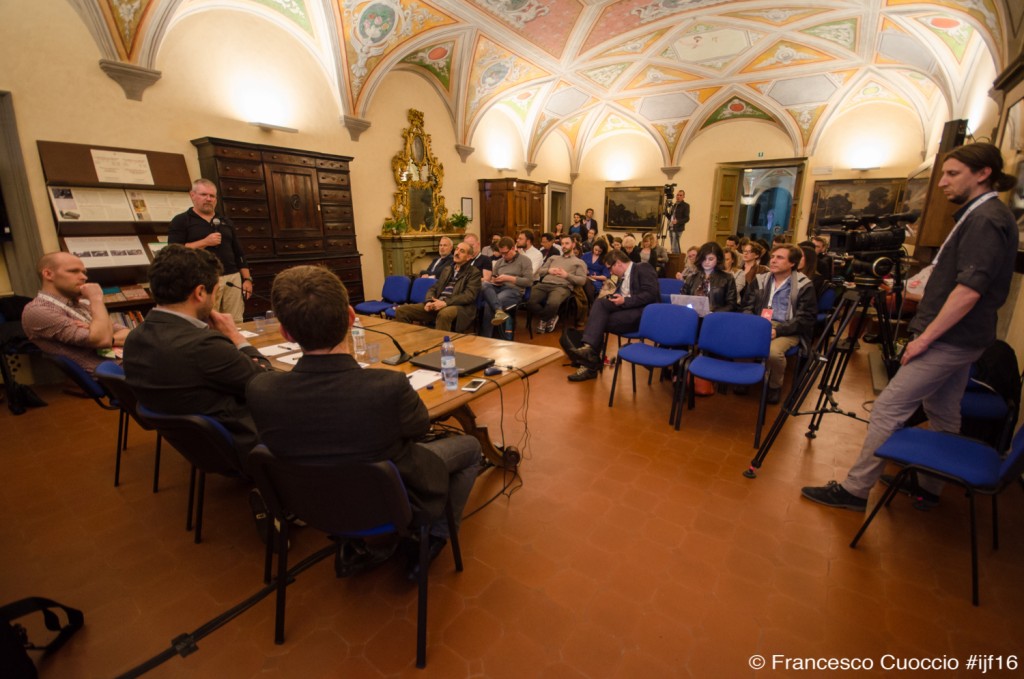Tech start-ups are becoming an essential part of digital newsrooms: they create tools to help media professionals discover, qualify, verify and distribute stories. But how hard is it to build a digital tool from scratch for journalists and editors?
Newsrooms adapting to the digital era have realised that constantly updated tools and products are keys to surviving in the tech world. In doing so, they have decided to rely on start-ups to build new options for them to explore new endeavours, and at the same time to save energy.
On 8 April, 2016 Mathew Ingram from Fortune Magazine discussed the issue in a panel at the International Journalism Festival with Mark Little, Vice President of Media Europe and Africa at Twitter, Claire McHugh, CEO of Axonista, James Neufeld, Founder and CEO of SAM,and Paul Quigley, Co-founder and CEO of NewsWhip.
The conversation started with the exploration of the reasons behind the four panellists’ decision to create a start-up in the first place: answers shifted from McHugh’s “sensing of the shifts in the market” to Neufeld’s “frustration around stories happening and no appropriate platform available to report them”.
According to Little, who founded Storyful, the first news agency of the social media age, the secret to being successful is all in our minds. “It’s all about your mental abilities to limit risk and overcome fear – the ability to look at yourself and know that crazy ideas that look like they are an utter failure are the ones that are going to change the world,” he said.
A concept that is shared by McHugh, who agreed that “you have to be a risk-taker, and be prepared to take risks. It can be quite a long and isolating journey and you have to learn how to fix problems on the way.”
In fact, the idea of solving a problem is at the core of the whole process of building up a product from scratch. The definition itself of start-up alludes to new beginnings: a company that ‘starts’ – and, of course, there needs to be something to be starting from.
“When you initiate a start-up, you have to think about the problem you are trying to solve and what your company is,” said Neufeld.
However, it is not just about bridging a gap in the market. According to McHugh, when launching a completely new product “you need to figure out the value you can bring to customers.” Something that can be quite tricky in an everchangin market such as the one that surrounds us. That is why the CEO of Axonista also recommended to “keep an eye on your users and on what is changing and don’t get stuck.”
What are the chances for a start-up to radically change its initial vision? Do you have to pivot at some point?
“It’s not pivoting, it’s shedding,” said Little.
The panel agreed that it is up to each and every start-up to draw up a plan of their own, which for most of them involves questioning what is the best strategy to go for to generate sales and revenue.
“We can help your newsroom, but we are going to do it on a paid model,” said Neufeld, bringing up one of the biggest dilemmas of the digital world. According to him, most of the users won’t convert a free trial into subscription, which is why SAM – aka Social Asset Managment – is available on a paid basis only.
The audience counter-argued this statement and asked how a newsroom could possibly trust a tool if there is no chance to test it. “There’s limits on how much you should own and we see some news organisations doing more than they should,” said Quigley. “Some organisations don’t have the time and resources to build such tools,” said McHugh.
When choosing a start-up to work with, another factor a newsroom has to look at is how much potential the company has to grow and stay alive. “There’s more great quality products that die than start-ups that succeed,” said Little. “When you bet on a start-up you know they are going to be around for a while.”
